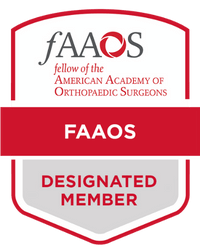Complex Ankle Specialists
Are you an active individual who participates in activities involving twisting or rotating? If so, you may be at an increased risk of experiencing a sprained ankle. Ankle sprains may be caused by damage to the medial ligament, deltoid ligament, ATFL, or the CFL. Sprained ankles vary in severity, so it is important to see an expert if you believe you may have sprained your ankle. Foot and ankle specialists Doctors Thomas Haytmanek and Jonathon Backus provide diagnosis and treatment for patients in Vail and Frisco, Colorado, as well as Denver, Boulder, and surrounding Summit County areas who have experienced a sprained ankle. Contact The Steadman Clinic’s Sports Foot and Ankle team today!

What is a sprained ankle?
Acute ankle sprain is the most common injury in sports. It occurs when the foot twists or rotates beyond its normal range of motion causing the ligaments to stretch or tear. The two ligaments on the lateral side of the ankle which are injured most often are the anterior talofibular ligament (ATFL) and calcaneofibular ligament (CFL). Sprains of the medial, or deltoid, ligaments occur less frequently as is the case for high ankle sprains, or syndesmosis sprains. The latter ligaments connect the tibia and fibula together where these bones play a critical in ankle function. Ankle sprains can affect just about anyone including athletes and non-athletes, men, women, children, and adults.
Ankle sprains happen most often in athletic activities, stepping on uneven surfaces, or tripping while walking. In most cases, a sprained ankle will heal itself over 3-6 weeks with conservative measures. If a sprain fails to heal as anticipated, this may indicate damage to structures other that the lateral ankle ligaments.
What are the symptoms of a sprained ankle?
The symptoms associated with a sprained ankle are typically determined by the severity of the injury. Ankle sprains are typically classified from grade 1 to grade 3, or as mild, moderate, or severe. Grade 1 sprains involve stretching of the ligaments; grade 2 sprains has a partial tear of one or two ligaments, and grade 3 sprains have a complete tear in a ligament. Symptoms will usually include pain, tenderness and swelling found in worsening degrees as the grade of injury worsens.
How is a sprained ankle diagnosed?
Our physicians will perform a complete history and examination of the ankle including x-rays. X-rays are needed to rule out a fracture of the ankle and evaluate for any bony avulsions around the ankle which occur when a ligament pulls off its bony attachment. Based on the degree of injury (pain level, overall range of motion and mobility), treatment options will be discussed. In some cases, we may order an MRI or CT scan to evaluate the damage to the ligaments and assess if any other structures were injured.
What is the treatment for a sprained ankle?
Many patients require a boot in order to walk with a sprained ankle comfortably, while some require only an ankle brace. Other treatment recommendations include RICE (rest, ice, compression, elevation), anti-inflammatory medications, or in some cases complete immobilization with casting. After a short course of rest, we typically recommend a functional rehabilitation program to work on strengthening, range of motion, balance and proprioception.
When does a sprained ankle require surgery?
For ankles that do not heal in an appropriate timeframe or for those with complex ligament tears, our physicians may recommend surgery to repair or reconstruct the damaged ligaments. These decisions are made on a case by case basis after a thorough evaluation of the patient. Our physicians take into account many associated factors including prior sprains, activity level, and imaging results.
How long does it take a sprained ankle to heal after treatment?
Following lateral ankle ligament repair or reconstruction, most patients require a short course of non-weight bearing. After sutures are removed and the soft tissue has begun to heal, patients will begin weight bearing on the ankle and start physical therapy. Our physicians are very particular about the therapy exercises after lateral ankle ligament surgery and will prescribe you an individualized plan for your physical therapist. Most patients are able to resume normal activities and partake in sports once the healing process has concluded in 6-8 weeks.
